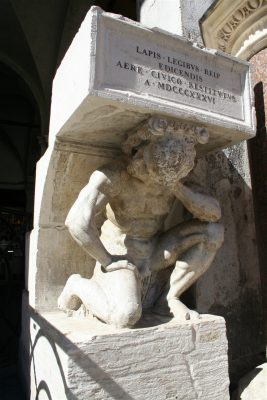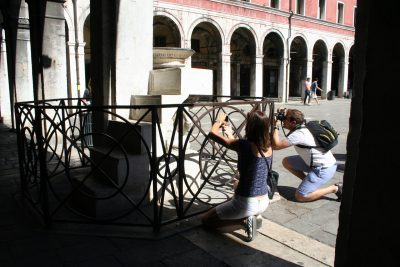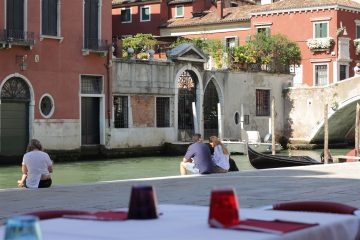Laatste update op 18 November 2017
The Hunchback (Il Gobbo) of Rialto is an odd, old little chap from the 16th century. He supports a fake marble staircase, what appears to cost him some effort. There is a good story to be told about this fellow. And who does not like a good story?
You can find the Gobbo di Rialto to the right side of the Canal Grande (seen from the mainland). The sculputre by Pietro da Salò is located quite near the Rialto-brug, next to Sotoportego della Sicurtà. Actually, this figure is not a hunchback at all: he is simply carrying weight. However, if if you have seen the statue, you will not be surprised by its nickname.
Official announcements
Rialto was the place where all Venetians gathered for their business and for the market. The daily shopping was done here, hence this spot was chosen by the authorities to announce laws, proclamations and punishments. The announcements were attached to the statue after they were read out loud. At the same time the annoucement would also be read out loud at the Piazza San Marco, so almost everyone would be notified.
Kiss of liberation
It is said that the statue communicates with Pasquino, one of the speaking statutes in Rome. However, there is some more of interest. Perhaps you know the Venetians were fond of cruel games. Now, the legend tells that the Gobbo di Rialto was the goal, the finish of one of these events. People being caught in the act of theft could choose to stay out of prison. Instead they had to run naked through the streets from Piazza San Marco to Rialto. During this trip they would be humiliated, hit and being laughed at. Reaching the Gobbo, a kiss on the statue would grant them their freedom.
In the end this happened that often that the authorities decided to place two stones on a nearby pillar as goal in March 1545. This was done with the intention to prevent that the Gobbo would become a symbol of liberation. One stone depicts the image of a cross, the other of San Marco. The statue was restored in 1836 (1892?), the commemorative stone shows an inscription in Latin as well as the restauration date.
Wikipedia mentions that the characters of Lancelot Gobbo and Old Gobbo of the story The merchant of Venice by William Shakespeare may have been inspired by the Gobbo of Rialto.
Links
Wikipedia, Gobbo di Rialto
The other Venice – the Hunchback of Rialto
The Gobbo of Rialto: often being photographed:







0 Comments